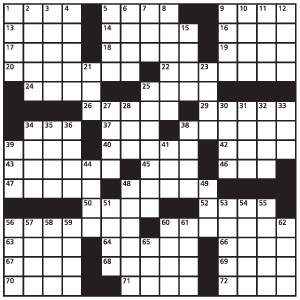 Crosswords are intriguing programming problems. How do you generate a New-York-Times-style crossword puzzle from a list of words? During an attempt (in Old English of course), I noticed some very interesting features of Old English words.
Crosswords are intriguing programming problems. How do you generate a New-York-Times-style crossword puzzle from a list of words? During an attempt (in Old English of course), I noticed some very interesting features of Old English words.
Consider the upper-left section of the crossword puzzle. An easy solution to generating words is to map the phonological shape of words before searching for instances of that shape in a list. So, an easy shape is consonants (C) and vowels (V) alternating. If 1-across is C-V-C-V, then the next word down, 13-across, is V-C-V-C. Then, you search the list of OE 4-letter words for that shape.
Say 1-across is C-V-C-V, bana ‘murderer’. 13-across might be V-C-V-C, eþel ‘homeland’. That sets up 1-down to start with b–e– and 2-down to start with æ–þ-. You’d think there would be plenty of words to fit that scheme.
But there are not! After extracting all words from the poetic corpus of Old English, I divided them into 3-, 4-, 5-, 6-, and 7-letter word lists. There are 133 tokens (words rather than lexemes) with the shape V-C-V-C:
abæd, abal, aban, aber, abit, acas, acol, acul, acyr, adam, adan, aðas, ades, adon, aðum, æcer, æðel, æfen, æfyn, ægen, æled, æleð, ænig, ænyg, æren, æres, æror, ærur, ætan, æten, ætes, æton, ætyw, æxum, afyr, agæf, agan, agar, agef, agen, agif, agof, agol, agon, agun, ahef, ahof, ahon, alæd, alæg, alæt, ales, alyf, alys, amæt, amen, amet, amor, anes, anum, arað, aras, ares, arim, aris, arod, arum, atol, aweg, awer, awoc, awox, axan, aþas, ecan, eces, ecum, eðan, eðel, edom, efen, enoc, enos, eror, etan, eteð, evan, eþel, ican, iceð, idel, ides, iren, isac, isen, isig, oðer, ofæt, ofen, ofer, ofet, ofir, ofor, onet, open, oreb, oroð, oruð, ower, oxan, oþer, ufan, ufon, ufor, upon, ures, urum, user, usic, utan, uten, uton, ycað, ycan, yced, yðum, yfel, ytum, ywan, ywaþ, ywed, yweð, yþum
And words with the shape C-V-C-V number 484:
bacu, baða, bæce, bæle, bære, bana, bare, baru, baþu, bega, bena, bene, bera, bere, bete, beþe, bide, bite, boca, boda, body, boga, bona, bote, bure, buta, bute, butu, byge, byme, byre, cafe, care, cele, cene, cepa, ciða, cile, come, cuðe, cuma, cume, cuþe, cyle, cyme, cymu, cyre, cyþe, dæda, dæde, dæge, dæle, dæne, ðæra, ðære, daga, dalu, ðane, ðara, dare, dege, dema, demæ, deme, dena, dene, ðere, ðine, dole, doma, dome, ðone, duna, dune, dura, dure, duru, dyde, ðyle, dyne, dyre, faca, fæce, fæge, fæla, fæle, fære, fana, fane, fara, fare, feða, feðe, fela, fele, fere, feþa, feþe, fife, fira, fire, five, fore, fota, fote, fula, fule, fuse, fyra, fyre, gara, gare, gatu, gedo, gena, geno, gere, geta, gife, gifu, gina, goda, gode, godu, gota, guðe, guma, gume, gute, guþe, gyfe, gyme, gyta, gyte, hada, hade, hæle, hælo, hælu, hæse, hæto, hafa, hafo, hafu, hale, hali, hama, hame, hara, hare, hata, hate, hefe, hege, hele, helo, here, hete, hewe, hige, hina, hine, hira, hire, hiwa, hiwe, hofe, hofu, hole, hopa, hope, horu, huðe, huga, huna, huru, husa, huse, huþa, huþe, hyde, hyðe, hyge, hyne, hyra, hyre, hyse, lace, laða, lade, laðe, læce, læde, læla, læne, lænu, lære, læte, lafe, lage, lago, lagu, lama, lame, lara, lare, lata, late, latu, laþe, lefe, lega, lege, lene, lete, lica, lice, lida, liða, lide, liðe, life, lige, lima, lime, liþe, liþu, locu, lofe, lufa, lufæ, lufe, lufu, lyfe, lyge, lyre, mæca, mæða, mæga, mæge, mæla, mæle, mæne, mæra, mære, mæro, mæru, mæte, maga, mage, mago, magu, mana, mane, mara, mare, meca, mece, meda, mede, meðe, medo, medu, melo, mere, mete, meþe, mide, mila, mine, moda, mode, modi, mona, more, mose, mote, muðe, muþa, muþe, myne, naca, næle, næni, nære, næte, nama, name, nane, neda, nede, nefa, nele, niða, niðe, nime, nine, niwe, niþa, niþe, noma, nose, noþe, nyde, nyle, race, racu, rade, raðe, ræda, ræde, raþe, rece, reða, reðe, rene, reþe, rica, rice, ricu, ride, rime, ripa, ripe, rode, rofe, rome, rope, rowe, rume, runa, rune, ryha, ryne, sace, sacu, sade, sæce, sæda, sæde, sæge, sæla, sæle, sæne, saga, sale, salo, salu, same, sara, saræ, sare, sari, sece, seðe, sefa, sege, sele, seme, sene, sete, sida, siða, side, siðe, sido, sige, sile, sina, sine, site, siþa, siþe, soða, soðe, some, sona, sone, soþa, soþe, sume, suna, suno, sunu, syle, syne, synu, sype, syre, syþe, tæle, tæso, tala, tale, tame, tane, tela, tene, tida, tiða, tide, tiðe, tila, tile, tima, tire, toða, tome, toþe, tuge, tyne, waca, wace, wada, wade, waðe, wado, wadu, waðu, wæda, wæde, wædo, wædu, wæge, wæle, wæra, wære, wæta, wage, wala, wale, walo, walu, wana, ware, waru, wega, wege, wela, wena, wene, wepe, wera, were, wese, wica, wida, wide, widu, wifa, wife, wiga, wige, wile, wina, wine, wire, wisa, wise, wita, wite, witu, woða, woma, wope, wora, woþa, wuda, wudu, wule, wuna, wyle, þæce, þæne, þæra, þære, þane, þara, þare, þine, þire, þone, þyle, þyre
Notice how many end with dative singular markers like –e. It suggests that we are looking at inflected forms of a C-V-C shape, one of the most common Proto-Indo-European root forms. Again, in the poetic corpus, there are 350 such tokens:
bad, bæc, bæd, bæð, bæg, bæl, bæm, bær, bam, ban, bat, bec, bed, beg, ben, bet, bid, bið, bil, bit, biþ, boc, boð, boh, bot, bur, byð, byþ, cam, can, cen, cer, ces, cið, col, com, con, cuð, cum, cuþ, cyð, cym, cyn, dæd, dæg, dæl, ðæm, ðær, ðæs, ðæt, ðah, ðam, ðan, ðar, ðas, day, ðec, deð, ðeð, ðeh, dem, ðem, ðer, ðes, ðet, deþ, dim, ðin, ðis, doð, dol, dom, don, ðon, dor, doþ, dun, ðus, dyn, ðyn, ðys, fæc, fær, fæt, fag, fah, fam, fan, far, fed, fel, fen, fet, fex, fif, fin, foh, fon, for, fot, ful, fus, fyl, fyr, fys, gad, gað, gæd, gæð, gæþ, gal, gan, gar, ged, gem, gen, get, gid, gif, gim, gin, git, god, guð, gyd, gyf, gyt, had, hæl, hær, hæs, hal, ham, har, hat, heg, heh, hel, her, het, hig, him, his, hit, hiw, hof, hoh, hol, hun, hus, hyd, hyð, hys, hyt, lac, lad, lað, læd, læf, læg, læn, lær, læs, læt, laf, lah, lar, laþ, lef, leg, len, let, lic, lid, lið, lif, lig, lim, lit, liþ, loc, lof, log, lot, lyt, mað, mæg, mæl, mæn, mæt, mæw, man, mec, men, mid, mið, min, mit, mod, mon, mor, mos, mot, muð, muþ, næs, nah, nam, nan, nap, nas, nat, neb, ned, neh, nes, nið, nim, nis, niþ, nom, non, num, nyd, nys, nyt, pyt, rad, ræd, ran, rec, ren, rex, rib, rim, rod, rof, rot, rum, run, ryn, sæd, sæl, sæm, sæp, sæs, sæt, sag, sah, sal, sar, sec, sel, sem, sib, sic, sid, sið, sin, sit, siþ, soð, sol, soþ, suð, sum, syb, syn, syx, syþ, tan, teð, teþ, tid, til, tin, tir, tor, tun, tyd, tyn, tyr, wac, wæf, wæg, wæl, wæn, wær, wæs, wæt, wag, wah, wan, was, wat, web, wed, weg, wel, wen, wep, wer, wes, wet, wic, wid, wið, wif, wig, win, wir, wis, wit, wiþ, woc, wod, woð, woh, wol, wom, won, wop, wyð, wyl, wyn, wyt, zeb, þæh, þæm, þær, þæs, þæt, þam, þan, þar, þas, þat, þec, þeh, þem, þer, þes, þet, þin, þis, þon, þus, þyð, þyn, þys
But the alternate, V-C-V has far fewer instances. I count 51:
ace, ada, aða, ade, aðe, ado, æce, æna, æne, æni, æra, æse, æte, æwæ, aga, age, ana, ane, ara, are, awa, awo, eca, ece, eci, eðe, ege, ele, ely, esa, ete, eþe, iða, ige, ipe, oga, ore, oxa, uðe, una, ura, ure, uta, ute, utu, uþe, yða, yðe, yne, yþa, yþe
269 of the CVC forms overlap with the CVCV forms, suggesting that
- CVCV forms that overlap with CVC forms are inflections of the root, or
- they are coincidentally similar and represent two different lexemes
As I continue to refine my OE Parser, I wonder whether employing PIE root forms might be useful in identifying lexemes. Certainly, when I turn to programming James E. Cathey’s tremendous diachronic phonology of Germanic languages, root form/shape will play an essential role. One of the methods I wrote in python checks for root form/shape, and I hoped to use it to identify spelling variants—allowing variation only in root vowels of a form. So: C-V(1)-C, C-V(2)-C, … C-V(n)-C.
Back to the crossword!






 SIMPLIFICATION. It is tempting to create lists that would quickly distinguish forms. For example, OE eadig ‘blessed’ is obviously an uninflected adjective (–ig). It could be almost nothing else. But the task of discerning its word class belongs to the syntactic strata, to
SIMPLIFICATION. It is tempting to create lists that would quickly distinguish forms. For example, OE eadig ‘blessed’ is obviously an uninflected adjective (–ig). It could be almost nothing else. But the task of discerning its word class belongs to the syntactic strata, to